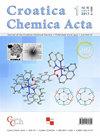Bifunctional Phenol Quinone Methide Precursors: Synthesis and Biological Activity
IF 0.9
4区 化学
Q4 CHEMISTRY, MULTIDISCIPLINARY
引用次数: 2
Abstract
New bifunctional quinone methide (QM) precursors, bisphenols 2a–2e, and monofunctional QM precursor 7 were synthesized. Upon treatment with fluoride, desilylation triggers formation of reactive intermediates, QMs, which was demonstrated by trapping QM with azide or methanol. The ability of QMs to alkylate and cross-link DNA was assayed by investigation of the effects of QMs to DNA denaturing, but without conclusive evidence. Furthermore, treatment of a plasmid DNA with compounds 2a–2e and KF, followed by the analysis by alkaline denaturing gel electrophoresis, did not provide evidence for the DNA cross-linking. MTT test performed on two human cancer cell lines (MCF7 breast adenocarcinoma and SUM159 pleomorphic breast carcinoma), with and without fluoride, indicated that 2a–2e or the corresponding QMs did not exhibit cytotoxic activity, in line with the lack of ability to cross-link DNA. The lack of reactivity with DNA and biological activity were explained by sequential formation of QMs where bifunctional cytotoxic reagent is probably never produced. Instead, the sequential generation of monofunctional QM followed by a faster hydrolysis leads to the destruction of biologically active reagent. The findings described here are particularly important for the rational design of new generation of QM precursor molecules that will attain desirable DNA reactivity and cytotoxicity.双官能酚醌甲基化物的合成及其生物活性
合成了新的双功能醌甲酰胺(QM)前体、双酚2a–2e和单功能QM前体7。在用氟化物处理时,脱硅引发反应性中间体QMs的形成,这通过用叠氮化物或甲醇捕获QM来证明。QMs烷基化和交联DNA的能力是通过研究QMs对DNA变性的影响来测定的,但没有确凿的证据。此外,用化合物2a-2e和KF处理质粒DNA,然后通过碱性变性凝胶电泳进行分析,并没有为DNA交联提供证据。在两种人类癌症细胞系(MCF7乳腺癌和SUM159多形性乳腺癌)上进行的MTT测试表明,在有氟和无氟的情况下,2a–2e或相应的QM没有表现出细胞毒性活性,这与缺乏交叉连接DNA的能力一致。与DNA缺乏反应性和生物活性的原因是QMs的连续形成,其中可能从未产生双功能细胞毒性试剂。相反,单功能QM的顺序生成,随后是更快的水解,导致生物活性试剂的破坏。这里描述的发现对于新一代QM前体分子的合理设计特别重要,该分子将获得所需的DNA反应性和细胞毒性。
本文章由计算机程序翻译,如有差异,请以英文原文为准。
求助全文
约1分钟内获得全文
求助全文
来源期刊

Croatica Chemica Acta
化学-化学综合
CiteScore
0.60
自引率
0.00%
发文量
3
审稿时长
18 months
期刊介绍:
Croatica Chemica Acta (Croat. Chem. Acta, CCA), is an international journal of the Croatian Chemical Society publishing scientific articles of general interest to chemistry.
 求助内容:
求助内容: 应助结果提醒方式:
应助结果提醒方式:


